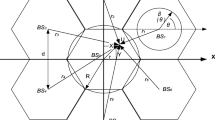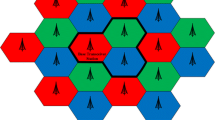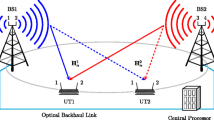Abstract
Recent research has shown that coordinated multi-point (CoMP) transmission can provide significant gains in terms of the overall throughput of cellular systems. The main purpose of this paper is to enhance the overall cell throughput and to optimize the power consumption in LTE-Advanced systems using CoMP. In particular, we present joint resource allocation, precoding and power allocation (PA) algorithms based on the signal-to-leakage-plus-noise-ratio (SLNR) for the CoMP downlink. The proposed resource allocation and precoding algorithm selects the user equipment that can efficiently share the same resource block in the same cell without degrading the overall throughput by using the SLNR metric. This sharing is possible due to the existence of multiple transmitters within a cell in a CoMP setting. Additionally, we propose a set of PA algorithms that significantly improve the overall throughput and reduce the power consumption. The PA algorithms are based on solving a set of constrained convex optimization problems using the log-barrier penalty function approach based on the Newton method. We evaluate the proposed PA algorithms by comparing them to the iterative water-filling (IWF) algorithm. Performance evaluation results show that the proposed SLNR-based PA algorithms provide considerable performance gains in terms of the overall system throughput and are also shown to have even less power consumption compared to the IWF.









Similar content being viewed by others
References
3GPP R1-050833, Interference mitigation in evolved UTRA/UTRAN, LGE Electronics.
Yu, W., Kwon, T., & Shin, C. (2010). Joint scheduling and dynamic power spectrum optimization for wireless multicell networks. In 2010 44th annual conference on information sciences and systems (CISS) (pp. 1–6). IEEE.
Parkvall, S., Dahlman, E., Furuskar, A., Jading, Y., Olsson, M., Wänstedt, S., et al. (2008). LTE-Advanced-Evolving LTE towards IMT-Advanced. In VTC Fall (pp. 1–5).
Dehghani, M., Arshad, K., & MacKenzie, R. (2015). LTE-Advanced radio access enhancements: A survey. Wireless Personal Communications, 80(3), 891–921.
Irmer, R., Droste, H., Marsch, P., Grieger, M., Fettweis, G., Brueck, S., & Jungnickel, V. (2011). Coordinated multipoint: Concepts, performance, and field trial results. IEEE Communications Magazine, 49(2), 102–111.
Sawahashi, M., Kishiyama, Y., Morimoto, A., Nishikawa, D., & Tanno, M. (2010). Coordinated multipoint transmission/reception techniques for LTE-advanced [coordinated and distributed MIMO]. IEEE Wireless Communications, 17(3), 26–34.
Wang, Q., Jiang, D., Liu, G., & Yan, Z. (2009). Coordinated multiple points transmission for LTE-advanced systems. In 5th International conference on wireless communications, networking and mobile computing, 2009 (WiCom’09) (pp. 1–4), IEEE.
Hosein, P. (2010). Coordinated radio resource management for the LTE downlink: The two-sector case. In 2010 IEEE international conference on communications (ICC) (pp. 1–5), IEEE.
Kiani, S. G., & Gesbert, D. (2008). Optimal and distributed scheduling for multicell capacity maximization. IEEE Transactions on Wireless Communications, 7(1), 288–297.
Xu, W., & Liang, L. (2014). On coordinated multi-point transmission with partial channel state information via delayed feedback. Wireless Personal Communications, 75(4), 2103–2119.
Kim, B., Malik, S., Moon, S., You, C., Liu, H., Kim, J. H., & Hwang, I. (2014). Performance analysis of coordinated multi-point with scheduling and precoding schemes in the LTE-A system. Wireless Personal Communications, 77(4), 2615–2630.
Alsharif, M. H., Nordin, R., & Ismail, M. (2014). Classification, recent advances and research challenges in energy efficient cellular networks. Wireless Personal Communications, 77(2), 1249–1269.
Hou, X., Bjornson, E., Yang, C., & Bengtsson, M. (2011). Cell-grouping based distributed beamforming and scheduling for multi-cell cooperative transmission. In 2011 IEEE 22nd international symposium on personal indoor and mobile radio communications (PIMRC) (pp. 1929–1933), IEEE.
Chen, C. S., & Baccelli, F. (2010). Self-optimization in mobile cellular networks: Power control and user association. In 2010 IEEE international conference on communications (ICC) (pp. 1–6), IEEE.
Garcia, V., Chen, C. S., Lebedev, N., & Gorce, J. M. (2011). Self-optimized precoding and power control in cellular networks. In 2011 IEEE 22nd international symposium on personal indoor and mobile radio communications (PIMRC) (pp. 81–85), IEEE.
Liu, X., Chong, E. K., & Shroff, N. B. (2002). Joint scheduling and power-allocation for interference management in wireless networks. In 2002 IEEE 56th vehicular technology conference, 2002 proceedings (VTC 2002-Fall) (vol. 3, pp. 1892–1896), IEEE.
Yu, W., Kwon, T., & Shin, C. (2013). Multicell coordination via joint scheduling, beamforming, and power spectrum adaptation. IEEE Transactions on Wireless Communications, 12(7), 1–14.
Gjendemsj, A., Gesbert, D., Oien, G. E., & Kiani, S. G. (2008). Binary power control for sum rate maximization over multiple interfering links. IEEE Transactions on Wireless Communications, 7(8), 3164–3173.
Cho, J. W., Mo, J., & Chong, S. (2009). Joint network-wide opportunistic scheduling and power control in multi-cell networks. IEEE Transactions on Wireless Communications, 8(3), 1520–1531.
Venturino, L., Prasad, N., & Wang, X. (2009). Coordinated scheduling and power allocation in downlink multicell OFDMA networks. IEEE Transactions on Vehicular Technology, 58(6), 2835–2848.
Abdelaal, R. A., Ismail, M. H., & Elsayed, K. (2012). Resource allocation strategies based on the signal-to-leakage-plus-noise ratio in LTE-A CoMP systems. In 2012 IEEE wireless communications and networking conference (WCNC) (pp. 1590–1595), IEEE.
Sadek, M., Tarighat, A., & Sayed, A. H. (2007). A leakage-based precoding scheme for downlink multi-user MIMO channels. IEEE Transactions on Wireless Communications, 6(5), 1711–1721.
Abdelaal, R. A., Elsayed, K. M., & Ismail, M. H. (2014). Joint scheduling and resource allocation with fairness based on the signal-to-leakage-plus-noise ratio in the downlink of CoMP systems. Wireless Personal Communications, 75(4), 1891–1913.
Yu, W. (2007). Multiuser water-filling in the presence of crosstalk. In Information theory and applications workshop, 2007 (pp. 414–420), IEEE.
Song, G., & Li, Y. (2003). Adaptive subcarrier and power allocation in OFDM based on maximizing utility. In The 57th IEEE semiannual vehicular technology conference, 2003 (VTC 2003-Spring) (vol. 2, pp. 905–909), IEEE.
Boyd, S., & Vandenberghe, L. (2004). Convex optimization. Cambridge: Cambridge University Press.
Yu, W., Ginis, G., & Cioffi, J. M. (2002). Distributed multiuser power control for digital subscriber lines. IEEE Journal on Selected Areas in Communications, 20(5), 1105–1115.
Yu, W., Rhee, W., Boyd, S., & Cioffi, J. M. (2004). Iterative water-filling for Gaussian vector multiple-access channels. IEEE Transactions on Information Theory, 50(1), 145–152.
Batista, R. L., dos Santos, R. B., Maciel, T. F., Freitas, W. C., & Cavalcanti, F. R. P. (2010). Performance evaluation for resource allocation algorithms in CoMP systems. In 2010 IEEE 72nd vehicular technology conference fall (VTC 2010-Fall) (pp. 1–5), IEEE.
IST-WINNER II, D1.1.2. (2007). WINNER II channel models, 2007. http://www.ist-winner.org/deliverables.html. Accessed March 2015
Acknowledgments
This work was carried out as part of the 4G++ research project supported by the National Telecom Regulatory Authority (NTRA) of Egypt.
Author information
Authors and Affiliations
Corresponding author
Rights and permissions
About this article
Cite this article
Abdelaal, R.A., Elsayed, K.M.F. & Ismail, M.H. Optimized Joint Power and Resource Allocation for Coordinated Multi-point Transmission for Multi-user LTE-Advanced Systems. Wireless Pers Commun 83, 2497–2518 (2015). https://doi.org/10.1007/s11277-015-2543-7
Published:
Issue Date:
DOI: https://doi.org/10.1007/s11277-015-2543-7




